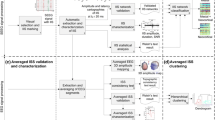Summary
Dipole source analysis of rolandic spike-and-wave complexes was performed in 48 children. The estimated source of the rolandic spike, of the trough between the spike and the following slow wave, and of the slow wave appeared to have the same position but had a small significant difference in orientation. Despite the heterogeneity of associated clinical syndromes, there were no clear differences between the clinical categories of patients regarding the localization and the orientation of the sources of the rolandic spike, trough and slow wave. The presence of a second source could explain the ascending phase of the rolandic spike in 19 children. This combination of two sources corresponded with the "double-spike phenomenon" that had been found previously by sequential brain mapping and which was associated with epilepsy. The preceding spike source and the source of the rolandic spike-and-wave complex were found to have the same position but a different orientation. A hypothetical explanation is proposed in which the presence of the rolandic spike-and-wave complex alone is insufficient to account for the clinical symptomatology. Both the preceding spike source and the source of the rolandic spike-and-wave complex, representing two separate, nearby but differently oriented populations of neurones in the inferior part of the rolandic cortex, is necessary for the development of epileptic manifestations.
Similar content being viewed by others
References
Buchsbaum, M.S., Hazlett, E., Sicotte, N., Ball, R. and Johnson, S. Geometric ans scaling issues in topographic electroencephalography. In: F.H. Duffy (Ed.), Topographic mapping of brain electrical activity. Butterworths, 1986: 325–337.
Chatrian, G.E., Lettich, E. and Nelson, P.L. Ten percent electrode system for topographic studies of spontaneous and evoked EEG activities. Am. J. EEG Technol., 1985, 25: 83–92
Cuffin, B.N., Cohen, D., Yunokuchi, K., Maniewski, R., Purcell, Ch., Cosgrove G.R., Ives, J., Kennedy, J. and Schomer, D. Tests of EEG localization accuracy using implanted sources in the human brain. Ann. Neurol., 1991, 29: 132–138.
De Munck, J.C. The estimation of time varying dipoles on the basis of evoked potentials. Electroenceph. clin. Neurophysiol., 1990, 77: 156–160.
Fender, D.H. Models of the human brain and the surrounding media: their influence on the reliability of source localization. Journal of Clinical Neurophysiology, 1991, 8(4): 381–390.
Gregory, D.L. and Wong, P.K. Topographical analysis of the centrotemporal discharges in benign rolandic epilepsy of childhood. Epilepsia, 1984, 25(6): 705–711.
Lerman, P. and Kivity-Ephraim, S. Focal epileptic EEG discharges in children not suffering from clinical epilepsy: etiology, clinical significance, and management. Epilepsia, 1981: 551–558.
Lerman, P. Benign partial epilepsy with centro-temporal spikes. In: J. Roger, C. Dravet, M. Bureau, F.E. Dreifuss and P. Wolf (Eds.), Epileptic syndromes in infancy, childhood and adolescence. John Libbey Eurotext, London, 1985: 150–158.
Lüders, H., Lesser, R.P., Dinner, D.S. and Morris III, H.H. Benign focal epilepsy of childhood. In: H. Lüders, and R.P. Lesser (eds.), Epilepsy. Electroclinical Syndromes, Springer Verlag, 1987: 303–346.
Nayrac, P. and Beaussart, M. Les pointes-ondes prérolandiques: expression E.E.G. très particulière. Rev. Neurol., 1958, 99: 201–206.
Penfield, W. and Jasper, H. Epilepsy and the functional anatomy of the human brain. Little, Brown and Compagny, Boston, 1954.
Touwen, B.C.L. Examination of the child with minor neurological dysfunction. In: Clinics in developmental medicine. Spastic International Medical Publiciations, 1979: 71.
Van der Meij, W., Van Huffelen, A.C., Wieneke, G.H. and Willemse, J. Sequential EEG mapping may differentiate "epileptic" from "non-epileptic" rolandic spikes. Electroenceph. clin. Neurophysiol., 1992, 82 (6): 408–414.
Van Oosterom A. History and evolution of methods for solving the inverse problem. Journal of Clinical Neurophysiology, 1991, 8(4): 371–380.
Weinberg, H., Wong, P.K.H., Crisp, D., Johnson, B. and Cheyne, D. Use of multiple dipole analysis for the classification of Benign Rolandic Epilepsy. Brain Topography, 1990, 3: 183–190.
Wong, P.K.H., Gregory, D. and Farrell, K. Comparison of spike topography in typical and atypical Benign Rolandic Epilepsy of Childhood. Electroenceph. clin. Neurophysiol., 1985, 61: S47.
Wong, P.K.H. Stability of source estimates in rolandic spikes. Brain Topography, 1989, 2: 31–36.
Wong. P.K.H. Source modelling of the rolandic focus. Brain Topography 1991, 4 (2): 105–112.
Author information
Authors and Affiliations
Additional information
We like to thank the Netherlands Ophthalmic Research Institute (I.O.I) and B.W. van Dijk for the availability of and help with the TWDIP program.
Rights and permissions
About this article
Cite this article
van der Meij, W., Wieneke, G.H. & van Huffelen, A.C. Dipole source analysis of rolandic spikes in benign rolandic epilepsy and other clinical syndromes. Brain Topogr 5, 203–213 (1993). https://doi.org/10.1007/BF01128988
Accepted:
Issue Date:
DOI: https://doi.org/10.1007/BF01128988



